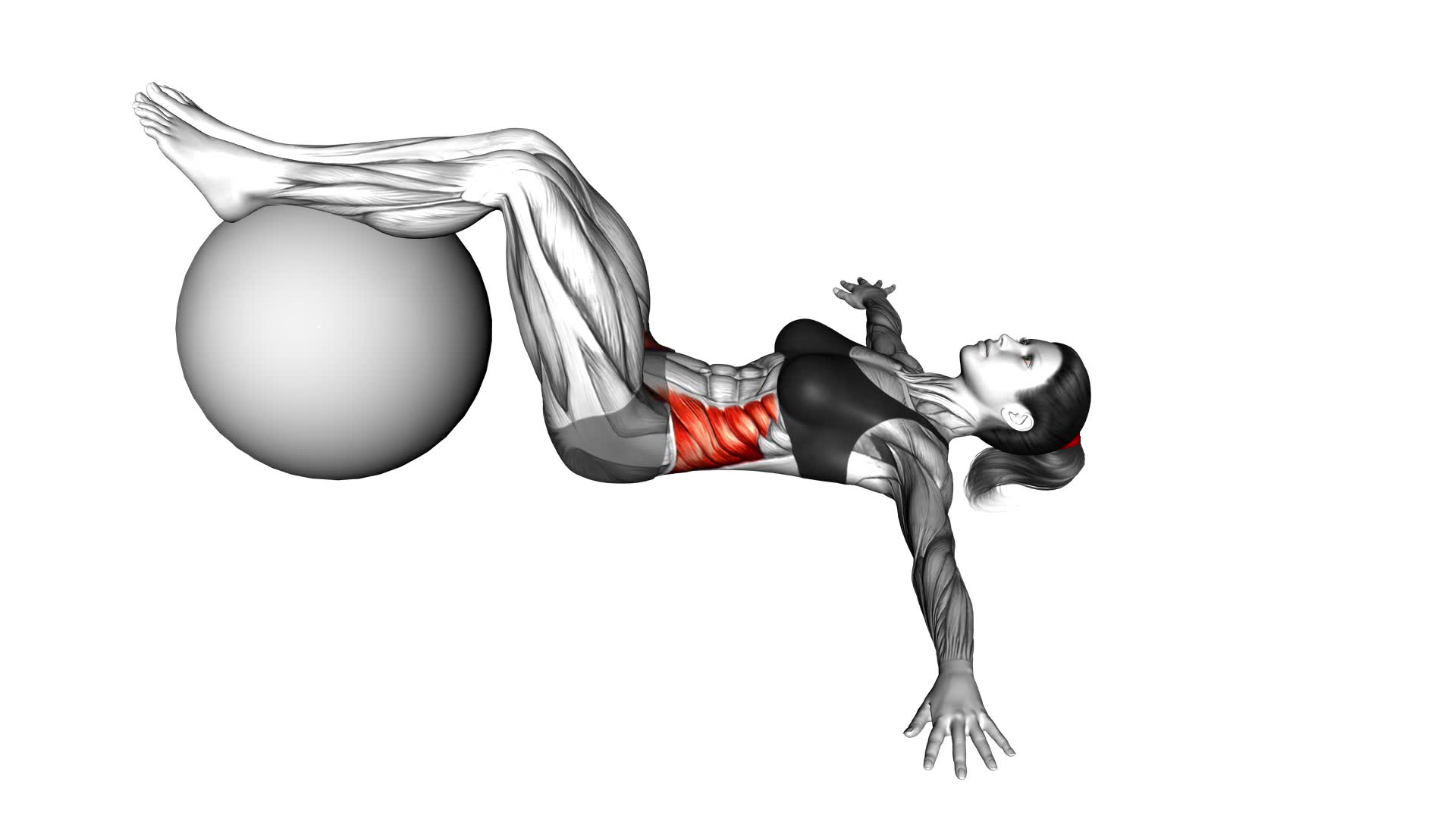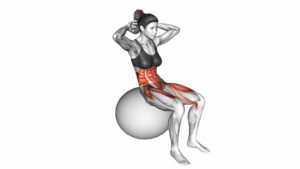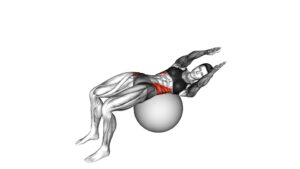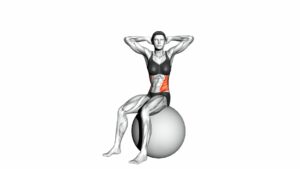Bent Knee Lying Twist (On Stability Ball) – Video Exercise Guide & Tips

Get ready to strengthen your core and improve your flexibility with the Bent Knee Lying Twist! In this video exercise guide, we'll show you the proper form and technique for this challenging move.
Watch This Exercise Video
Whether you're a beginner or an advanced fitness enthusiast, we've got modifications to suit your level. Avoid common mistakes and get the most out of this exercise with our helpful tips.
Let's get started on sculpting those abs and obliques!
Key Takeaways
- The Bent Knee Lying Twist targets multiple muscle groups and promotes flexibility and core strength.
- Proper form and technique are important for maximizing the effectiveness of the exercise and avoiding injury.
- Modifications can be made for different fitness levels, such as starting without a stability ball for beginners or adding weights for advanced individuals.
- Consistency, progression, and focusing on proper form and technique are key for optimal results.
Benefits of the Bent Knee Lying Twist
Experience the numerous benefits of the Bent Knee Lying Twist, a compound exercise that targets multiple muscle groups and promotes flexibility and core strength.
This exercise is highly effective in improving core strength and increasing spinal mobility. By engaging your core muscles, including the abdominals, obliques, and lower back, the Bent Knee Lying Twist helps to stabilize and support your spine during movements. This, in turn, contributes to better overall posture and spinal alignment.
The Bent Knee Lying Twist also plays a crucial role in increasing spinal mobility. As you twist your torso while keeping your legs bent and grounded, you activate the muscles along your spine, enhancing its range of motion. This can lead to improved flexibility and reduced stiffness in the back.
In addition to its core-strengthening and spinal mobility benefits, the Bent Knee Lying Twist also engages other muscle groups. The exercise targets your glutes, hips, and thighs, helping to tone and strengthen these areas. By incorporating this exercise into your routine, you can enhance your overall muscular strength and endurance.
To maximize the benefits of the Bent Knee Lying Twist, it's important to maintain proper form throughout the exercise. Remember to engage your core muscles and breathe deeply as you perform the twisting motion. Start with a lighter weight or no weight at all to ensure proper technique before progressing to heavier loads.
Proper Form and Technique
You should frequently practice proper form and technique when performing the Bent Knee Lying Twist on a stability ball. This exercise may seem simple, but it's essential to maintain correct form to avoid injury and maximize its benefits.
One common misconception is that you should rush through the movement. However, it's crucial to perform the exercise slowly and controlled, focusing on engaging your core muscles. Another misconception is that you need to twist your upper body excessively.
In reality, the twist should originate from your core, with your upper body and lower body moving together. To perform the Bent Knee Lying Twist with proper form, start by lying on your back on the stability ball, with your knees bent and feet flat on the floor. Place your hands behind your head, keeping your elbows wide. Engage your core and lift your upper body slightly off the ball.
As you exhale, rotate your torso to one side, keeping your lower body stable. Inhale and return to the starting position, then repeat on the other side. Remember to maintain control and avoid any jerky movements.
As you become more advanced, you can add variations to the exercise, such as using a medicine ball or adding resistance bands for an extra challenge.
Modifications for Different Fitness Levels
As you progress in your fitness journey, you can tailor the Bent Knee Lying Twist on a stability ball to your specific needs and abilities. Whether you're a beginner looking for adaptations or an experienced individual seeking advanced variations, there are modifications available to suit every fitness level. Here are three options to consider:
- Adaptations for beginners: If you're new to this exercise, you can start by performing the Bent Knee Lying Twist without using a stability ball. Lie on your back with your knees bent and feet flat on the ground. Instead of twisting your torso, you can begin by simply moving your knees from side to side. This will help you build strength and stability in your core before progressing to the stability ball.
- Advanced variations for experienced individuals: Once you've mastered the basic Bent Knee Lying Twist on a stability ball, you can challenge yourself by adding weights. Hold a dumbbell or medicine ball in your hands as you perform the twist, increasing the resistance and intensity of the exercise. Additionally, you can experiment with different tempos, incorporating slow and controlled movements or quick and explosive twists to target your muscles in different ways.
Remember to listen to your body and only progress to more advanced variations when you feel ready. It's important to maintain proper form and technique throughout the exercise to avoid injury and maximize results.
Common Mistakes to Avoid
To ensure proper execution and maximize the benefits of the Bent Knee Lying Twist on a stability ball, it's crucial to be aware of common mistakes that should be avoided. By understanding these common errors in executing the bent knee lying twist, you can make sure you're getting the most out of this exercise and preventing any potential injuries.
One common mistake is allowing your hips to lift off the stability ball during the twist. This reduces the effectiveness of the exercise and puts strain on your lower back. To avoid this mistake, focus on keeping your hips firmly planted on the stability ball throughout the movement. Engage your core muscles to maintain stability and control.
Another mistake to avoid is twisting too far or too quickly. This can strain your back and neck and increase the risk of injury. Instead, aim for controlled and gradual twists, focusing on engaging your oblique muscles. Listen to your body and only twist as far as feels comfortable for you.
Lastly, be mindful of your breathing. Holding your breath during the exercise can create tension and reduce the effectiveness of the twist. Remember to inhale deeply as you prepare for the twist and exhale as you rotate your torso.
Tips for Getting the Most Out of This Exercise
To maximize the benefits of the Bent Knee Lying Twist on a stability ball, it's important to incorporate these tips into your exercise routine.
- Variations for advanced practitioners: Once you have mastered the basic Bent Knee Lying Twist on a stability ball, you can challenge yourself by incorporating variations. Try extending your legs straight instead of keeping them bent, or hold a dumbbell or medicine ball to add resistance and engage your muscles even more.
- Best time to incorporate the bent knee lying twist into your workout routine: The Bent Knee Lying Twist is a great exercise to incorporate into your core or full-body workout routine. It can be done as a warm-up exercise to activate your core muscles, or as a standalone core exercise to improve stability and flexibility. You can also perform it at the end of your workout as a cool-down stretch to release tension in your muscles.
- Maintain proper form: To get the most out of this exercise, it's crucial to maintain proper form. Keep your back straight and your core engaged throughout the movement. Focus on rotating from your torso, not just your arms or shoulders. Take your time and move in a controlled manner, avoiding any jerky or fast movements.
Frequently Asked Questions
How Many Repetitions Should I Do for the Bent Knee Lying Twist Exercise?
To determine the number of repetitions for the bent knee lying twist exercise, consider your fitness level and goals. It's important to start with proper technique, engaging your core and keeping your movements controlled. Gradually increase the number of repetitions as you progress.
You may also try variations like using dumbbells or adding a stability challenge by lifting your legs off the stability ball. Remember to listen to your body and adjust the intensity as needed.
Is the Bent Knee Lying Twist Exercise Safe for Individuals With Lower Back Pain?
If you have lower back pain, it's important to find alternative exercises that won't exacerbate your condition.
The Bent Knee Lying Twist exercise mightn't be the best option for you.
However, incorporating stability ball exercises can provide relief for lower back pain. These exercises help improve core strength and stability, which can alleviate pain.
Consider trying other stability ball exercises like pelvic tilts or hip bridges to target your lower back without causing discomfort.
Can This Exercise Be Done Without a Stability Ball?
You can definitely do alternative exercises to the Bent Knee Lying Twist without a stability ball. However, using a stability ball has its benefits.
It helps to engage your core muscles, improve balance, and increase the range of motion in your spine. Without the stability ball, you may not get the same level of challenge and activation in those areas.
What Muscles Does the Bent Knee Lying Twist Target?
The bent knee lying twist targets your core muscles, including the obliques and rectus abdominis. By incorporating variations of the bent knee lying twist into your workout routine, you can strengthen and tone these muscles.
This exercise also helps improve spinal mobility and flexibility. Adding the bent knee lying twist to your routine can be a great way to challenge your core and enhance your overall fitness level.
How Long Should I Hold the Twist Position During the Exercise?
To get the most out of the bent knee lying twist exercise, it's important to hold the twist position for about 10-15 seconds. This allows your muscles to engage and stretch properly.
Remember to maintain proper form and technique throughout the exercise.
If you're looking for modifications or variations, you can try using a smaller stability ball or adding weights for an extra challenge.
Make sure to listen to your body and adjust accordingly.
Conclusion
In conclusion, the bent knee lying twist on a stability ball is a beneficial exercise for improving core strength and flexibility. By following proper form and technique, individuals of all fitness levels can benefit from this exercise.
It's important to avoid common mistakes and focus on getting the most out of the exercise by engaging the core muscles and maintaining stability. Incorporate this exercise into your fitness routine to enhance your overall strength and stability.

Author
Years ago, the spark of my life’s passion ignited in my mind the moment I stepped into the local gym for the first time. The inaugural bead of perspiration, the initial endeavor, the very first surge of endorphins, and a sense of pride that washed over me post-workout marked the beginning of my deep-seated interest in strength sports, fitness, and sports nutrition. This very curiosity blossomed rapidly into a profound fascination, propelling me to earn a Master’s degree in Physical Education from the Academy of Physical Education in Krakow, followed by a Sports Manager diploma from the Jagiellonian University. My journey of growth led me to gain more specialized qualifications, such as being a certified personal trainer with a focus on sports dietetics, a lifeguard, and an instructor for wellness and corrective gymnastics. Theoretical knowledge paired seamlessly with practical experience, reinforcing my belief that the transformation of individuals under my guidance was also a reflection of my personal growth. This belief holds true even today. Each day, I strive to push the boundaries and explore new realms. These realms gently elevate me to greater heights. The unique combination of passion for my field and the continuous quest for growth fuels my drive to break new ground.







